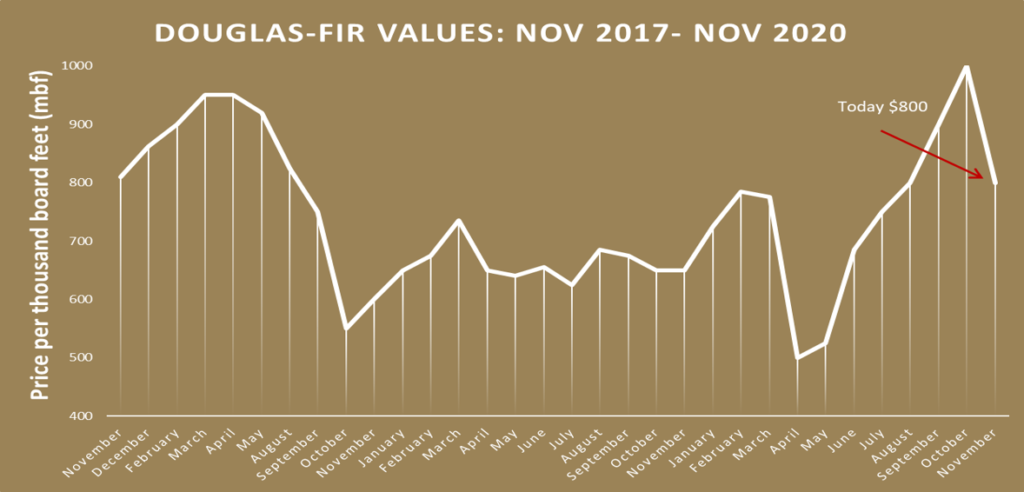By Lauren Grand, OSU Extension Forestry & Natural Resources, Lane County
Things got hot and heavy this summer with prices increasing to the $900/mbf range. While these prices aren’t record breaking, we set those in the summer of 2017, lumber prices were. Record breaking lumber prices along with a reduction in wood as a result of the coronavirus brought up those log process to numbers rarely seen in the summer. Usually a bad fire season also adds to a slight increase in price as we come out of the summer due to equipment shut downs, slowing wood to the mills. But, we didn’t have just a bad fire season, we had a bad fire year. As we recover from the Labor Day fires, many landowners will be looking to salvage their burned timber and this increase in wood to the mill will likely start to drive down prices.
Right now, some mills are taking both green and burned wood. However, you’ll be hard pressed to find a mill willing to take charred wood. Green wood is fresh cut timber that was not burned in a fire. Burned wood is timber that burned in the fire, but only the bark, not the wood, was damaged. Charred wood is timber that was in the fire and both the wood and the bark was damaged. In the fire world, high winds make fire behavior more intense and the fire harder to fight. The silver lining here is that because of the winds, the fire moved so fast that it mostly burned and scorched the trees and didn’t do as much consumption. This means that unless the trees had spike knots or previous scars, it is unlikely that you have a lot of charred wood on your hands and most of it is in the “burned” category.
Now for the meat. Green wood Douglas-fir prices are currently sitting in the high $700 – low $800/mbf range. This is lower than the prices you saw last month, because more wood is headed to the mills which causes lumber prices to start to decrease (but still higher than historic summer prices). There will be a discount price for burned wood and either a huge discount or cull ($0) for charred wood. Make sure you understand the mill or yard’s specifications when selling fire salvage timber.

Chips haven’t been exciting in the recent past, and this quarter is no different. There seems to be a steady stream of
chips coming as byproduct from the lumber mills to satisfy most of the fiber market in the area. Chip and saw can be an option for you if you have smaller trees that were in the fire, but the bark is thinner on smaller trees. Thinner bark means increased damage and fiber mills can’t use burned chips. Right now chips are in the high $20-$30 per ton range.
The current pole market is good and buyers are taking burned wood, but no char. Buyers are looking for everything from a 30 foot to 135 foot pole height, but the 45 and 55 footers with a 23 inch minimum diameter and 85-100 footers are in the highest demand. Prices are strong with purchase orders going out at over $1000 for 30 footers.
The Hem-fir sorts (spruce, hemlock, grand and white fir) are not too exciting this quarter but if you search you might find some good prices. I’m seeing prices in the $400 – $600/mbf range. These species have thinner bark and are therefore more susceptible to wood damage during a fire so logs coming from the burned areas are closer to $300/mbf. Be sure to investigate the burned versus char status of these species.
Typically, trends in the Alder market follow Douglas-fir, but more recently have been slowing down and flattening out. They are up a bit from last quarter and are sitting in the $500/mbf range.
Redcedar prices are on the rise from last quarter and are in high demand, fetching $1300/mbf, which is $300/mbf more than our last report. Incense-cedar on the other hand is holding steady. If you are in the Eugene area you are looking at $550/mbf and $650/mbf in Douglas County area. Port-Orford-cedar prices are holding steady in the $475 range.
It isn’t Christmas yet, but in the non-timber forest products game that’s the buzz. It is all about trees and greenery right now. Most other products are on hold now but will likely start up again in December.
So, to salvage or not to salvage? Hopefully your property hasn’t burned and you don’t have to worry about this question. If your wood is green and it fits in your plans to harvest, now might be a good time since we are possibly heading into a wood surplus as a result of the fires which will likely drive down the prices. Remember winter is coming and dirt roads will be off limits soon. If your property has burned you might consider salvaging, but it depends on your objectives. Burned wood will only be good on the stump for about a year and larger trees last longer than smaller ones. If you wait until the spring, there will be more insects entering the wood and your mill choices will decrease to those that sell dried lumber. If you plan to harvest, note that loggers will be in high demand since there will be so much clean up to do, and unfortunately there was a lot of equipment lost in the fires. Make sure to find your logger early and be a bit flexible. Good luck and always remember to get your purchase order before you cut!


